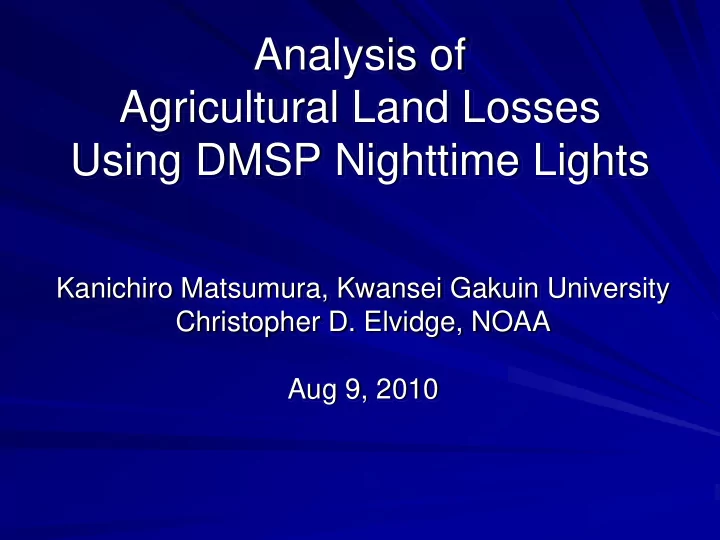

Analysis of Agricultural Land Losses Using DMSP Nighttime Lights Kanichiro Matsumura, Kwansei Gakuin University Christopher D. Elvidge, NOAA Aug 9, 2010
Abstract Nocturnal light data, collected by multiple satellites in 1992, 2000, and 2008, are used to analyze agricultural land losses. Overlaying DMSP datasets on vegetation datasets. We attempted to calculate agricultural land losses by using spatial information for 1992, 2000, and 2008.
GDP (nominal value) and light volume in 2002 Regression Coefficient Constant Correlation Coefficient Significance 0.87 12.01 0.823 1%
Demand for Land Economic development and increase in the population result in the demand for lands for industrial areas, roads and infrastructure. Land use and cover change have occurred. Agricultural production plays an important role in coping with the population increase and is calculated from yield and harvested area. The Food and Agricultural Organization (FAO) provides a time series of the harvested area by country.
Reclassifying night time data Where light is observed as “value 1”, and the areas where light is off “value 0” for the datasets in 1992, 2000, and 2008. 2008 2000 1992
Multiplying reclassified datasets We multiplied 1 for the dataset in 1992, multiplied 10 for the dataset in 2000 and multiplied 100 for the dataset in 2008. The points where light is observed in 1992, 2000, and 2008 were individually expressed as “1,” “10,” and “100” respectively.
Multiplying reclassified datasets The points where light is observed in 1992, and 2000, as “11,” those in 1992, and 2008, as “110,” and those in 2000 and 2008, as “110.”
Multiplying reclassified datasets The obtained datasets for western part of Japan and China.
Reclassifying vegetation data Vegetation data sets developed by the Global Mapping Project conducted by Geographical Survey Institute (GSI).
Reclassifying vegetation data Cropland, paddy field and cropland/other vegetation as agricultural land and reclassified these 3 legends as value “1”. Crop Land Vegetation and Other Paddy Filed
Analysis Assuming that night time lights on agricultural land express agricultural land losses. We multiply the night-time datasets by the agricultural land. Subsequently, we can estimate the change of agricultural land losses in 1992, 2000, and 2008. We used the zonal statistics tools of ArcGIS software to calculate the cell number of the agricultural land with night-time.
Analysis The vegetation value for 1992 is obtained using the following formula: total – 1 – 11 – 111: For 2000, using the following formula: total – 10 – 11 – 110-111: For 2008, using the following formula: total – 100 – 101 – 110 -111. We assume the vegetation for 1992= to be 100.
Comparing Statistical Data Crop land change (x-axis: statistical value, y-axis:gridded value) for 1992, 2000 , and 2008
Comparing Statistical Data Paddy field change (x-axis: statistical value, y-axis: gridded value) for 1992, 2000 , and 2008
Comparing Statistical Data Cropland/vegetation change (x-axis: statistical value, y-axis: gridded value) for 1992, 2000 , and 2008
Comparing Statistical Data Cropland/vegetation change (x-axis: statistical value, y-axis: gridded value) for 1992, 2000 , and 2008
Conclusion Overlaying global scale night time light data for 1992, 2000, and 2008 on the vegetation map, we tried to calculate the agricultural land losses. The results were compared with the country based statistical value. The areas of crop and crop/vegetation change drastically year by year. According to farmers, it is important to plant crops on the basis of producer prices. The change does not appear as big with respect to rice.
Future works For future research, we should consider the coherence of association between gridded vegetation and FAO-STAT more precisely. we need to consider a newly developed agricultural area for a type bush in Brazil. We also take into account the intensity of lights. The possibilities of using DMSP datasets on agricultural land losses are investigated.
Acknowledgements Night time image and data processing was performed by NOAA’s National Geophysical Data Center. The DMSP data were collected by the US Air Force Weather Agency
References 1. Night time data,Available at http://www.ngdc.noaa.gov/dmsp/global_composites_v2.html 2. Elvidge, C.D., Sutton,P.S., Baugh, K.E., Tuttle, B.T., Howard, A.T., Erwin, E.H., and Bhaduri, B., A Global Poverty Map Derived From Satellite Data, 2006, Available at:http://www.ngdc.noaa.gov/dmsp/download_poverty.html 3. Nakaya, T.: A Grid-surface Projection of Urban and Rural Population in China, 1990- 2050, in Otsubo, K. ed.: Study on the Processes and Impact of Land-use Change in China-Final Report of the LU/GEC Second Phase (1998-2000) - , Centre for Global Environmental Research, 2002, pp. 89-98. 4. Imhoff, M. L., Lawrence, W. T., Stutzer, D. C. and Elvidge C. D.: A Technique for Using Composite DMSP/OLS “City lights” Satellite Data to Map Urban Area, Remote Sensing Environment 61, 1997, pp. 361-370 5. FAO STAT (2009) Available at: http://faostat.fao.org/site/567/default.aspx 6. GSI, Chiba University, Collaborating Organizations. Original data set Available at:http://www1.gsi.go.jp/geowww/globalmap-gsi/gm-gaiyo.html
Recommend
More recommend